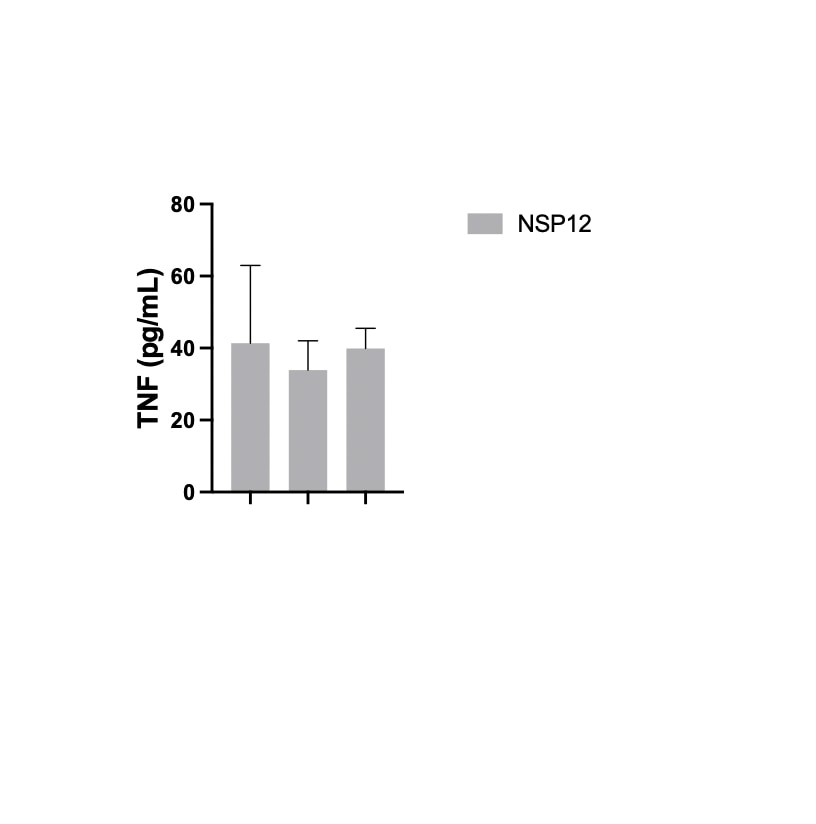Recombinant SARS-CoV-2 NSP12 His-tag Protein, CF Summary
Product Specifications
Ser1-Gln932
with an N-terminal Met and a C-terminal 6-His tag
Analysis
Product Datasheets
Carrier Free
CF stands for Carrier Free (CF). We typically add Bovine Serum Albumin (BSA) as a carrier protein to our recombinant proteins. Adding a carrier protein enhances protein stability, increases shelf-life, and allows the recombinant protein to be stored at a more dilute concentration. The carrier free version does not contain BSA.
In general, we advise purchasing the recombinant protein with BSA for use in cell or tissue culture, or as an ELISA standard. In contrast, the carrier free protein is recommended for applications, in which the presence of BSA could interfere.
10686-CV
| Formulation | Supplied as a 0.2 μm filtered solution in HEPES, NaCl, MgCl2, TCEP and Glycerol. |
| Shipping | The product is shipped with polar packs. Upon receipt, store it immediately at the temperature recommended below. |
| Stability & Storage: | Use a manual defrost freezer and avoid repeated freeze-thaw cycles.
|
Scientific Data
 View Larger
View Larger
2 μg/lane of Recombinant SARS-CoV-2 NSP12 His-tag (Catalog # 10686-CV) was resolved with SDS-PAGE under reducing (R) and non-reducing (NR) conditions and visualized by Coomassie® Blue staining, showing a band at ~92 kDa under reducing conditions.
Reconstitution Calculator
Background: NSP12
Non-structural protein 12 (NSP12) contains RNA-dependent RNA polymerase (RdRp) catalytic activity and is commonly identified as the viral RdRp (1). It is one of several functional proteins released by ORF1a-encoded protease cleavage of the pp1a and pp1ab replicase polyproteins expressed from the coronavirus (CoV) genome (2). The NSPs are involved in the replication and transcription of the viral RNA and not incorporated within the virion particles. Coronaviruses include various highly pathogenic strains such as SARS-CoV, MERS-CoV and SARS-CoV2 that have had significant impact on humans in addition to strains that have negatively impacted livestock. NSP12 is a multidomain 932 amino acid enzyme. The C-terminal polymerase domain is responsible for the synthesis of viral RNA and consequently plays a central role in the replication and transcription cycle of SARS-CoV2. The RdRp is considered a primary target for antiviral inhibition through development of chain-terminating nucleotide analogs. The polymerase active site includes seven conserved motifs maintained across most viral RdRps as well as divalent-cation-binding and catalytic residues (3-5). Several nucleotide analog drugs such as remdesivir have shown potential for treatment of SARS-CoV2 viral infections (6, 7). Additional analogs such as sofosbuvir have been effective in Hepatitis C infection (3, 8) suggesting viral RdRps can be used to target development of more potent or broader-spectrum antiviral inhibitors (4). While SARS-CoV2 RdRp has been shown to have minimal activity on its own, the polymerase activity is stimulated in the presence of NSP7 & NSP8 cofactors that form a complex and effectively lower the dissociation rate of NSP12 from RNA (9). NSP12 can interact with the NSP7 and NSP8 heterodimer or NSP8 alone (1, 4). NSP12 has separately been shown to bind several host proteins including receptor-interacting protein kinase 1 (RIPK1) and may play a role in modulating host cell response (10). The C-terminal polymerase domain is connected via an interface domain (4) to a conserved N-terminal extension domain that has nucleotidylation activity (NiRAN domain). The presence of the NiRAN domain is essential for replication (11) and has homology to the nucleotide-binding site of protein kinases (12) suggesting NSP12 may play a role as a guanylyl transferase in the capping pathway (11) that stabilizes viral RNA.
- Hartenian, E. et al. (2020) J. Biol. Chem. 295:12910.
- Snijder, E.J. et al. (2016) Adv. Virus Res. 96:59.
- Appleby, T.C. et al. (2015) Science. 347:771.
- Gao, Y. et al. (2020) Science. 368:779.
- Yin, W. et al. (2020) Science. 368:1499.
- Lu, C-C. et al. (2020) J. Chin. Med. Assoc. 83:534.
- Sheahan, T.P. et al. (2020) Sci. Transl. Med. 12:eabb5883.
- Gane, E.J. et al. (2013) N. Engl. J. Med. 358:34.
- Subissi, L. et al. (2014) Proc. Natl. Acad. Sci. USA 111:E3900.
- Gordon, D.E. et al. (2020) Nature. 53:459.
- Lehmann, K.C. et al. (2015) Nucleic Acids Res.43:8416.
- Kirchdoerfer, R.N. and A.B. Ward (2019) Nat. Commun. 10:2342.
Citation for Recombinant SARS-CoV-2 NSP12 His-tag Protein, CF
R&D Systems personnel manually curate a database that contains references using R&D Systems products. The data collected includes not only links to publications in PubMed, but also provides information about sample types, species, and experimental conditions.
1 Citation: Showing 1 - 1
-
Discovery and functional interrogation of SARS-CoV-2 protein-RNA interactions
Authors: G Yeo, J Xiang, J Mueller, EC Luo, B Yee, D Schafer, J Schmok, F Tan, K Rothamel, R McVicar, E Kwong, B Croker, K Jones, HL Her, CY Chen, A Vu, W Jin, S Park, P Le, K Brennan, E Kofman, Y Li, A Tankka, K Dong, Y Song, A Clark, A Carlin, EV Nostrand, S Leibel
Research square, 2022-03-17;0(0):.
Species: N/A
Sample Types: Recombinant Protein
Applications: Bioassay
FAQs
No product specific FAQs exist for this product, however you may
View all Proteins and Enzyme FAQsReviews for Recombinant SARS-CoV-2 NSP12 His-tag Protein, CF
Average Rating: 4 (Based on 1 Review)
Have you used Recombinant SARS-CoV-2 NSP12 His-tag Protein, CF?
Submit a review and receive an Amazon gift card.
$25/€18/£15/$25CAN/¥75 Yuan/¥2500 Yen for a review with an image
$10/€7/£6/$10 CAD/¥70 Yuan/¥1110 Yen for a review without an image
Filter by:

